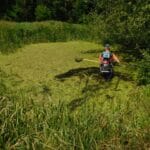By Katie Thralls Butte, PhD, MS, CSCS
Can you remember when you first learned to tie shoes? Maybe you recall the repetitive practice of the “bunny ear” or the “squirrel around the tree” methods. You may remember the struggle it was to learn this skill, a feat usually accomplished around four years old. When you could independently put on those new lace up shoes and run to grade school, it was a victory!
Tying shoes, as with many other fine motor functions of the hand, is a complex skill that takes practice and coordination of small muscles coupled with brain coordination to learn and accomplish. Other familiar motor skills include picking up playing cards from a table, buttoning a shirt, playing the piano, handwriting a letter, or even spooning a big delicious scoop of ice cream into your mouth. Once learned, we spend the majority of life taking for granted our ability to smoothly complete these skills. These fine motor skills allow us to enjoy a high quality of life by mindlessly accomplishing many routine tasks or enjoyable hobbies with minimal effort.
As we age, there is a natural decline in the ability to manipulate the hands for fine motor skills, similar to larger motor functions like running, walking, and squatting. Yet, research shows that larger functions, such as walking and standing from a chair, can be maintained during aging by those who participate in regular physical activity. However, will physical activity, such as going for a walk or participating in an exercise class, also maintain fine motor skills, such as tying shoes?
Under Dr. Thralls Butte’s training and mentorship, university students, majoring in Health and Human Performance, aimed to answer this question by conducting a research study at a local retirement community. After gaining the proper university and retirement community approval as well as trainings in conducting specific measurements, they began the study.
The research study summary…
The students conducted physical assessments involving fine motor skills with the hands as well as an interview-assisted survey asking about physical activity behaviors. Study participants were over 60 years, not cognitively impaired, and varied in their level of physical activity. Accounting for age and gender, participants were categorized based on how many minutes of physical activity they averaged each week: “inactive” (<150 min/wk), “moderately active” (150-300 min/wk), and “active” (>300 min/wk). Interestingly, the study found after age 79, physical activity has promising benefits to help maintain those small important daily tasks that we take for granted.
The results…
While participants under 80 showed no difference in hand motor functions regardless of their physical activity level, for those over 80 years old, the “active” participants performed significantly better than the “moderately active” and “inactive” groups. Further, the “moderately active” performed better than the “inactive” group. While physical activity does not appear to have any effect on fine motor skills in the 70s, similar to those in their 20s, 30s, or 40s, it does have myriad other benefits, not the least of which is being able to continue that very physical activity in later years in order to reap these benefits! These findings are even more important as the life expectancy age increases and we work to find the best strategies to maintain the highest quality of life for as long as possible.
Whether you are 30, 60, or 90, each time you lace up those shoes for a nice walk or other fitness routine, be encouraged by the many benefits it will have for the rest of your life – including tying your shoes again tomorrow!
Katie Thralls Butte, PhD, MS, CSCS is an Assistant Professor at Seattle Pacific University in the Department of Health and Human Performance. Her research focuses on physical activity and sedentary behavior in older adults to maintain physical function for independence and quality of life.
Senior Outlook Today is your go-to source for information, inspiration, and connection as you navigate the later years of life. Our team of experts and writers is dedicated to providing relevant and engaging content for seniors, covering topics such as health and wellness, finances, technology and travel.






